Related Research Articles

Bread is a staple food prepared from a dough of flour and water, usually by baking. Throughout recorded history and around the world, it has been an important part of many cultures' diet. It is one of the oldest human-made foods, having been of significance since the dawn of agriculture, and plays an essential role in both religious rituals and secular culture.

Pastry is a dough of flour, water and shortening that may be savoury or sweetened. Sweetened pastries are often described as bakers' confectionery. The word "pastries" suggests many kinds of baked products made from ingredients such as flour, sugar, milk, butter, shortening, baking powder, and eggs. Small tarts and other sweet baked products are called pastries. Common pastry dishes include pies, tarts, quiches, croissants, and pasties.

A croissant is a buttery, flaky, viennoiserie pastry of Austrian origin, but mostly associated with France. Croissants are named for their historical crescent shape and, like other viennoiseries, are made of a layered yeast-leavened dough. The dough is layered with butter, rolled and folded several times in succession, then rolled into a thin sheet, in a technique called laminating. The process results in a layered, flaky texture, similar to a puff pastry.
In cooking, a leavening agent or raising agent, also called a leaven or leavener, is any one of a number of substances used in doughs and batters that cause a foaming action that lightens and softens the mixture. An alternative or supplement to leavening agents is mechanical action by which air is incorporated. Leavening agents can be biological or synthetic chemical compounds. The gas produced is often carbon dioxide, or occasionally hydrogen.
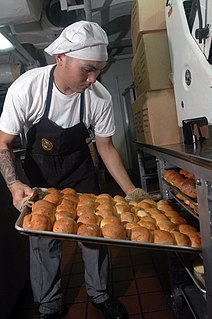
A baker is a tradesperson who bakes and sometimes sells breads and other products made of flour by using an oven or other concentrated heat source. The place where a baker works is called a bakery.

A baguette is a long, thin type of bread of French origin that is commonly made from basic lean dough. It is distinguishable by its length and crisp crust.

Dough is a thick, malleable, sometimes elastic paste made from grains or from leguminous or chestnut crops. Dough is typically made by mixing flour with a small amount of water or other liquid and sometimes includes yeast or other leavening agents, as well as ingredients such as fats or flavorings.
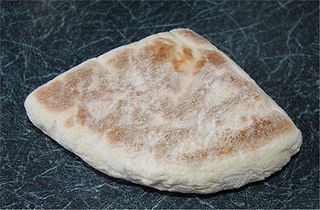
Soda bread is a variety of quick bread traditionally made in a variety of cuisines in which sodium bicarbonate is used as a leavening agent instead of the traditional yeast. The ingredients of traditional soda bread are flour, baking soda, salt, and buttermilk. The buttermilk in the dough contains lactic acid, which reacts with the baking soda to form tiny bubbles of carbon dioxide. Other ingredients can be added, such as butter, egg, raisins, or nuts. An advantage of quick breads is their ability to be prepared quickly and reliably, without requiring the time-consuming skilled labor and temperature control needed for traditional yeast breads.
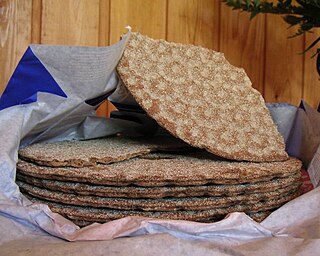
Crispbread is a flat and dry type of cracker, containing mostly rye flour. Crispbreads are lightweight and keep fresh for a very long time due to their lack of water. Crispbread is a staple food and was for a long time considered a poor man's diet. However, in recent years there has been renewed interest in crispbread in the Nordic countries.

A bread making machine or breadmaker is a home appliance for turning raw ingredients into baked bread. It consists of a bread pan, at the bottom of which are one or more built-in paddles, mounted in the center of a small special-purpose oven. This small oven is usually controlled by a simple built-in computer using settings input via a control panel. Most bread machines have different cycles for different kinds of dough—including white bread, whole grain, European-style, and dough-only. Many also have a timer to allow the bread machine to activate without operator attendance, and some high-end models allow the user to program a custom cycle.

Ciabatta is an Italian white bread made from wheat flour, water, salt, yeast and olive oil, created in 1982 by a baker in Adria, province of Rovigo, Veneto, Italy, in response to the popularity of French baguettes. Ciabatta is somewhat elongated, broad, and flat, and is baked in many variations, although unique for its alveolar holes. Ciabatta is made with a strong flour and uses a much wetter dough than traditional French bread.

Rye bread is a type of bread made with various proportions of flour from rye grain. It can be light or dark in color, depending on the type of flour used and the addition of coloring agents, and is typically denser than bread made from wheat flour. It is higher in fiber than white bread and is darker in color and stronger in flavor.
The Chorleywood bread process (CBP) is a method of efficient dough production- making bread quickly, producing a soft, fluffy loaf. It was developed by Bill Collins, George Elton and Norman Chamberlain of the British Baking Industries Research Association at Chorleywood in 1961. As of 2009, 80% of bread made in the United Kingdom used the process. Compared to the older bulk fermentation process, the CBP is able to use lower-protein wheat, and produces bread in a shorter time.
The sponge and dough method is a two-step bread making process: in the first step a sponge is made and allowed to ferment for a period of time, and in the second step the sponge is added to the final dough's ingredients, creating the total formula. In this usage, synonyms for sponge are yeast starter or yeast pre-ferment. In French baking the sponge and dough method is known as levain-levure. The method is reminiscent of the sourdough or levain methods; however, the sponge is made from all fresh ingredients prior to being used in the final dough.

A dough conditioner, flour treatment agent, improving agent or bread improver is any ingredient or chemical added to bread dough to strengthen its texture or otherwise improve it in some way. Dough conditioners may include enzymes, yeast nutrients, mineral salts, oxidants and reductants, bleaching agents and emulsifiers. They are food additives combined with flour to improve baking functionality. Flour treatment agents are used to increase the speed of dough rising and to improve the strength and workability of the dough. While they are an important component of modern factory baking, some small-scale bakers reject them in favour of longer fermentation periods that produce greater depth of flavour.
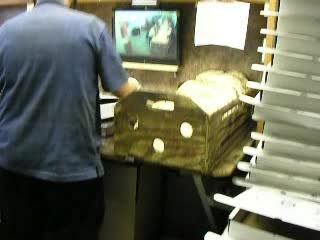
The dough offering is a positive commandment requiring the owner of a bread dough to give a part of the kneaded dough to a kohen. The obligation to separate the dough offering from the dough begins the moment the dough is kneaded, but may also be separated after the loaves are baked. This commandment is one of the twenty-four kohanic gifts, and, by a biblical injunction, is only obligatory in the Land of Israel, but from a rabbinic injunction applies also to breadstuffs made outside the Land of Israel.
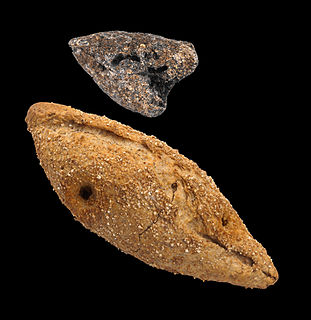
The Ovelgönne bread roll is the remaining part of a bread roll originating from the Pre-Roman Iron Age of Northern Europe, which was found in 1952 during archaeological excavations in a loam mine in the Buxtehude district Ovelgönne in Lower Saxony, Germany. The piece of bread is the oldest surviving formed bakery product from Europe. The find, along with a reconstruction, are in the permanent exhibition of the Archaeological Museum Hamburg in Harburg, Hamburg.

Mexican breads and other baked goods are the result of centuries of experimentation and the blending of influence from various European baking traditions. Wheat, and bread baked from it, was introduced by the Spanish at the time of the Conquest. The French influence in Mexican Bread is the strongest. From the bolillo evolving from a French baguette to the concha branching out from a French brioche even the terminology comes from France. A baño maría, meaning a water bath for a custard type budín or bread pudding comes from the French word bain marie. While the consumption of wheat has never surpassed that of corn in the country, wheat is still a staple food and an important part of everyday and special rituals. While Mexico has adopted various bread styles from Europe and the United States, most of the hundreds of varieties of breads made in the country were developed here. However, there is little to no baking done in Mexican homes; instead, Mexicans have bought their baked goods from bakeries since the colonial period.

Straight dough is a single-mix process of making bread. The dough is made from all fresh ingredients, and they are all placed together and combined in one kneading or mixing session. After mixing, a bulk fermentation rest of about 1 hour or longer occurs before division. It is also called the direct dough method.

Manitoba flour, a name chiefly used in Italy, is a flour of common wheat originating in the Canadian province of Manitoba. It is called a "strong" flour to distinguish it from other, weaker flours. The flour strength is indicated by the value of the coefficient "W" measured with a Chopin alveograph: the higher the value, the stronger the flour. A weak flour has a W value lower than 170 while the manitoba has a W value higher than 350.
References
- ↑ Edwards, W. P. (2007). "5: Flour testing". The Science of Bakery Products. Royal Society of Chemistry. p. 142. ISBN 978-0-85404-486-3.
- ↑ "Alveograph". Practically edible. 2009. Archived from the original on 2007-07-11. Retrieved 2009-09-19.
- ↑ "Décret n° 63-720 du 13 juillet 1963 relatif à la composition des farines de blé, de seigle et de méteil". Journal officiel de la République française. Lois et décrets n° 0169 du 20/07/1963. 169: 6722. 20 July 1963.
- ↑ Alconada, T. M.; Moure, M. C.; Ortega, L. M. (2019-08-26). "Fusarium infection in wheat, aggressiveness and changes in grain quality: a review". Vegetos . Springer. 32 (4): 441–449. doi:10.1007/s42535-019-00054-z. ISSN 2229-4473.
- ↑ Parenti, Ottavia; Guerrini, Lorenzo; Mompin, Sara Bossa; Toldrà, Mònica; Zanoni, Bruno (2021). "The determination of bread dough readiness during kneading of wheat flour: A review of the available methods". Journal of Food Engineering . International Society of Food Engineering (Elsevier). 309: 110692. doi:10.1016/j.jfoodeng.2021.110692. ISSN 0260-8774.